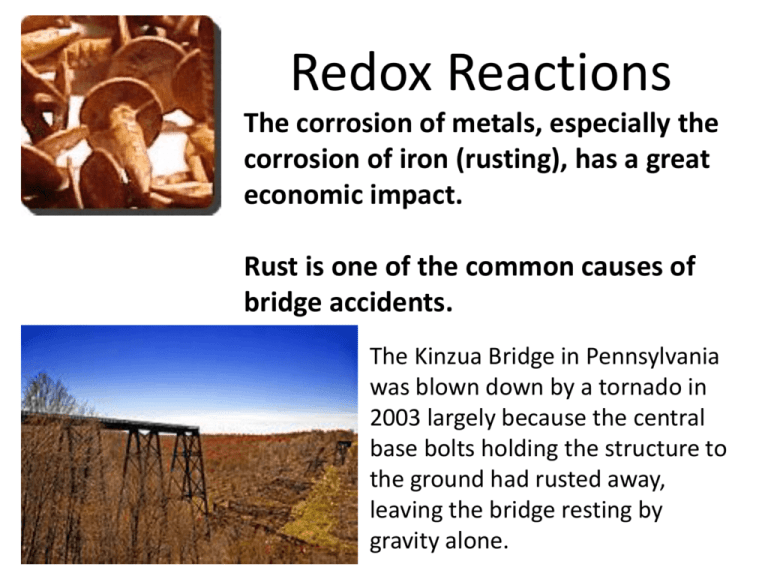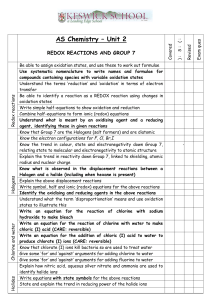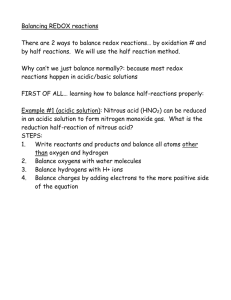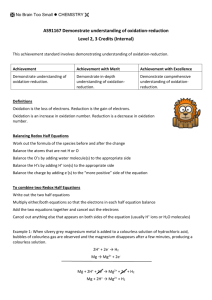Redox Reactions
advertisement

Redox Reactions The corrosion of metals, especially the corrosion of iron (rusting), has a great economic impact. Rust is one of the common causes of bridge accidents. The Kinzua Bridge in Pennsylvania was blown down by a tornado in 2003 largely because the central base bolts holding the structure to the ground had rusted away, leaving the bridge resting by gravity alone. Redox Reactions Rust fears for Harbour Bridge NZ Herald 22/03/2009 And aofcable -report an "essential" part of the bridge's bracing system The January One theHarbour walkways bythat independent been engineers used by"structurally Bridge said the Climb rust wasfor Auckland Bridge ishad rusting away at significant earthquakes andengineers high winds hasthe been disconnected to deal with starting forcing operators tois"detrimentally corroded, necessitating affect structure". safety repairs,work. according to an points", to -step up maintenance more rust. Other cables can bear the weight when one is engineering report. disconnected. Redox Reactions Explain why this reaction is a redox reaction! Give more than one answer. Gain/loss of oxygen/hydrogen, gain/loss of electrons (transfer), increase/decrease in Ox.number Remember: • A redox reaction is any reaction involving a transfer of electrons. • In all redox reactions, oxidation and reduction happen at the same time. • Oxidation is loss of electrons/ increase in oxidation number. • Reduction is gain of electrons/decrease in oxidation number. • Oxidising agents (oxidants) are themselves reduced. • Reducing agents (reductants) are themselves oxidised. Redox Reactions Examples: Write the oxidation number for each of the underlined atoms: PbO2 +4 BrO3- +5 [FeSCN]2+ +3 Redox Reactions Complete worksheet #1 Example: Use oxidation numbers to determine whether the following reaction is a redox reaction, and if so, which element has been oxidised, and which has been reduced: It is a redox reaction. The nitrogen in ammonia has been oxidised (ON increased). The oxygen has been reduced (ON decreased). 0 -3 0 -2 4NH3(g) + 3O2(g) → 2N2(g) + 6H2O(l) Colours of species in redox reactions The colour of any species depends on the oxidation number. You are expected to know a number of species and their colours. Reduced form brown Cu SO2 Mn2+ H2O2 H2O Cr3+ blue/green Fe2+ pale green ClBrH2 solid gas aq liquid liquid aq aq aq aq gas Oxidised form blue Cu2+ SO42H+/MnO4- purple O2 H2O2 orange Cr2O72orange Fe3+ pale green Cl2 red/orange Br2 H+ aq aq aq gas liquid aq aq gas liquid aq Reduced form MnO2 brown MnO42- green II2 in I- = I3- brown H2S Pb2+ brown NO2 C2O42S2O32red/orange Br2 Oxidised form solid H2O/MnO4- purple aq aq OH-/MnO4- purple aq aq I2 in I- = I3IO3S PbO2 NO3CO2 S4O62BrO3- brown aq aq gas aq gas aq aq liquid aq yellow/white solid brown solid aq gas aq aq C2O42S2O32S4O62BrO3IO3- Names of unfamiliar ions: Oxalate ion (from oxalic acid) Thiosulfate ion Tetrathionate Bromate Iodate Rhubarb contains oxalic acid. This makes your teeth feel furry. Citrobacter live in the intestines of warm blooded animals, without oxygen. They can respire by converting tetrathionate into thiosulfate. Recognising species (observations): Some species can be recognised by their colour. For example: The purple permanganate ion (MnO4-) can be reduced in alkaline conditions (presence of OH-). The product is the green manganate ion (MnO42-). Observation: the purple solution turns green. Recognising species (observations): Complete worksheet #2 Some species can not be recognised by their colour as they are colourless or do not have a distinct colour. Therefore you need to memorise some tests to detect these species: I2: turns blue/black with starch solution SO42- : forms a white precipitate with H+/BaCl2 Fe3+ : forms a blood red solution with KSCN Cl2 : turns damp starch-iodide paper blue/black Balancing complicated half equations Cr2O72- → Cr3+ 1. Balance the atoms that aren’t O or H. Cr2O72- → 2Cr3+ 2. Balance the oxygen by adding water. Cr2O72- → 2Cr3+ + 7H2O 3. Balance the hydrogens by adding H+. Cr2O72- + 14H+ → 2Cr3+ + 7H2O 4. Add electrons to the side that is more positive. Cr2O72- + 14H+ + 6e- → 2Cr3+ + 7H2O Balancing complicated half equations SO2 → SO421. Balance the atoms that aren’t O or H. SO2 → SO422. Balance the oxygen by adding water. SO2 + 2H2O → SO423. Balance the hydrogens by adding H+. SO2 + 2H2O → SO42-+ 4H+ 4. Add electrons to the side that is more positive. SO2 + 2H2O → SO42-+ 4H+ + 2e- Combining the half equations The number of electrons in the two half equations needs to be the same. Therefore the half equations have to be multiplied by a factor. Combining the half equations Cr2O72- + 14H+ + 6e- → 2Cr3+ + 7H2O SO2 + 2H2O → SO42-+ 4H+ + 2eMultiply whole equation by 3 3 SO2 + 6H2O → 3 SO42-+ 12H+ + 6e- Combining the half equations Cr2O72- + 14H+ + 6e- → 2Cr3+ + 7H2O 3 SO2 + 6H2O → 3 SO42-+ 12H+ + 6eCr2O72- + 14H+ + 3 SO2 + 6H2O→2Cr3+ + 7H2O + 3 SO42-+ 12H+ 5. Cancel out H+ and H2O. Cr2O72- + 2H+ + 3 SO2 → 2Cr3+ + H2O + 3 SO42- Balancing redox equations in acidic/neutral conditions Last year you learned the steps to balance redox reactions. One of the steps included adding H+ ions. H+ ions are present in small amounts in neutral conditions (same as OH- ions). In acidic conditions H+ ions are present in a higher concentration than OH- ions. It is therefore ok if your redox equations contain H+ ions as they are present. Balancing redox equations in acidic/neutral conditions The permanganate ion can be reduced in neutral, acidic and in alkaline conditions. Each of these conditions leads to a different product. Write down the balanced half equations for the reduction or permanganate in acidic conditions (producing Mn2+), Answers Acidic: + 2+ MnO4 + 8H + 5e → Mn + 4H2O Now write a balanced half equation for the reduction of permanganate in neutral conditions (producing MnO2). Answers Neutral: + MnO4 + 4H + 3e → MnO2+ 2H2O H+ ions are relatively scarce. Add OH- ions to both sides of the equation to neutralise. - MnO4 + 2H2O + 3e → MnO2+ 4OH Balancing redox equations in alkaline conditions The permanganate ion can also be reduced in alkaline conditions, producing the manganate ion (MnO42-). Write a balanced half equation using the usual steps. If adding H+ ions (which are scarce in the alkaline solution) is necessary, add an equal amount of OH- ions to both sides of the equation. Answer Alkaline: 2MnO4 + e → MnO4 Complete worksheet #3 Key Learning Outcomes You should now be able to: • • • Determine the oxidation number of any atom in a compound or ion and use oxidation numbers to identify the oxidised and reduced species in a reaction. Recall common oxidising and reducing agents, state the colours of the reagents and their products, and recall any other observations or conditions characteristic of their use. Write ion-electron equations for oxidation and reduction half-reactions and combine the half equations to give a balanced ionic equation.




